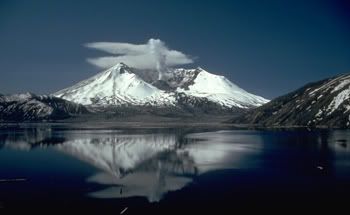
Mt. St. Helens, Washington State
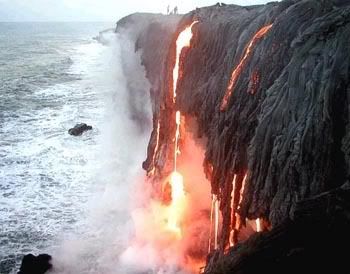
Lava from Kilauea Flowing into the Pacific Ocean, Hawaii Volcanoes National Park
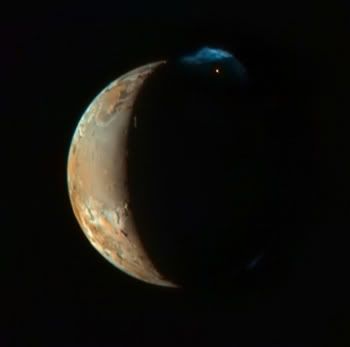
A complex plume rises over 300 kilometers above the horizon of Jupiter's moon Io in this image from cameras onboard the New Horizons spacecraft. The volcano, Tvashtar, is marked by the bright glow (about 1 o'clock) at the moon's edge, beyond the terminator or night/day shadow line.

A Lenticular Cloud Above Mt. Rainier, Washington State
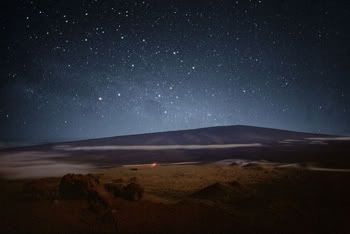
The Southern Cross in the Night Sky Above Massive Mauna Loa in Hawaii
Everything You've Ever Wanted to Know About Volcanoes and More from Wikipedia
_____________________________
A volcano is an opening, or rupture, in a planet's surface or crust, which allows hot, molten rock, ash, and gases to escape from below the surface. Volcanic activity involving the extrusion of rock tends to form mountains or features like mountains over a period of time.
Volcanoes are generally found where tectonic plates are pulled apart or come together. A mid-oceanic ridge, for example the Mid-Atlantic Ridge, has examples of volcanoes caused by "divergent tectonic plates" pulling apart; the Pacific Ring of Fire has examples of volcanoes caused by "convergent tectonic plates" coming together. By contrast, volcanoes are usually not created where two tectonic plates slide past one another. Volcanoes can also form where there is stretching and thinning of the Earth's crust (called "non-hotspot intraplate volcanism"), such as in the African Rift Valley, the Wells Gray-Clearwater Volcanic Field and the Rio Grande Rift in North America and the European Rhine Graben with its Eifel volcanoes.
Volcanoes can be caused by "mantle plumes". These so-called "hotspots", for example at Hawaii, can occur far from plate boundaries. Hotspot volcanoes are also found elsewhere in the solar system, especially on rocky planets and moons.
Plate Tectonics and Hotspots
At the mid-oceanic ridges, two tectonic plates diverge from one another. New oceanic crust is being formed by hot molten rock slowly cooling and solidifying. The crust is very thin at mid-oceanic ridges due to the pull of the tectonic plates. The release of pressure due to the thinning of the crust leads to adiabatic expansion, and the partial melting of the mantle causing volcanism and creating new oceanic crust. Most divergent plate boundaries are at the bottom of the oceans, therefore most volcanic activity is submarine, forming new seafloor. Black smokers or deep sea vents are an example of this kind of volcanic activity. Where the mid-oceanic ridge is above sea-level, volcanic islands are formed, for example, Iceland.
Subduction zones are places where two plates, usually an oceanic plate and a continental plate, collide. In this case, the oceanic plate subducts, or submerges under the continental plate forming a deep ocean trench just offshore. Water released from the subducting plate lowers the melting temperature of the overlying mantle wedge, creating magma. This magma tends to be very viscous due to its high silica content, so often does not reach the surface and cools at depth. When it does reach the surface, a volcano is formed. Typical examples for this kind of volcano are Mount Etna and the volcanoes in the Pacific Ring of Fire.
Hotspots
Hotspots are not usually located on the ridges of tectonic plates, but above mantle plumes, where the convection of the Earth's mantle creates a column of hot material that rises until it reaches the crust, which tends to be thinner than in other areas of the Earth. The temperature of the plume causes the crust to melt and form pipes, which can vent magma. Because the tectonic plates move whereas the mantle plume remains in the same place, each volcano becomes dormant after a while and a new volcano is then formed as the plate shifts over the hotspot. The Hawaiian Islands are thought to be formed in such a manner, as well as the Snake River Plain, with the Yellowstone Caldera being the part of the North American plate currently above the hotspot.
Volcanic features
The most common perception of a volcano is of a conical mountain, spewing lava and poisonous gases from a crater at its summit. This describes just one of many types of volcano, and the features of volcanoes are much more complicated. The structure and behavior of volcanoes depends on a number of factors. Some volcanoes have rugged peaks formed by lava domes rather than a summit crater, whereas others present landscape features such as massive plateaus. Vents that issue volcanic material (lava, which is what magma is called once it has escaped to the surface, and ash) and gases (mainly steam and magmatic gases) can be located anywhere on the landform. Many of these vents give rise to smaller cones such as Puʻu ʻŌʻō on a flank of Hawaii's Kīlauea.
Other types of volcano include cryovolcanoes (or ice volcanoes), particularly on some moons of Jupiter, Saturn and Neptune; and mud volcanoes, which are formations often not associated with known magmatic activity. Active mud volcanoes tend to involve temperatures much lower than those of igneous volcanoes, except when a mud volcano is actually a vent of an igneous volcano.
Shield volcanoes
Shield volcanoes, so named for their broad, shield-like profiles, are formed by the eruption of low-viscosity lavas that can flow a great distance from a vent, but not generally explode catastrophically. The Hawaiian volcanic chain is a series of shield cones, and they are common in Iceland, as well.
Lava domes
Lava domes are built by slow eruptions of highly viscous lavas. They are sometimes formed within the crater of a previous volcanic eruption (as in Mount Saint Helens), but can also form independently, as in the case of Lassen Peak. Like stratovolcanoes, they can produce violent, explosive eruptions, but their lavas generally do not flow far from the originating vent.
Cinder cones
Volcanic cones or cinder cones result from eruptions that erupt mostly small pieces of scoria and pyroclastics (both resemble cinders, hence the name of this volcano type) that build up around the vent. These can be relatively short-lived eruptions that produce a cone-shaped hill perhaps 30 to 400 meters high. Most cinder cones erupt only once. Cinder cones may form as flank vents on larger volcanoes, or occur on their own. Parícutin in Mexico and Sunset Crater in Arizona are examples of cinder cones. In New Mexico, Caja del Rio is a volcanic field of over 60 cinder cones.
Stratovolcanoes (composite volcano)
Stratovolcanoes are tall conical mountains composed of lava flows and other ejecta in alternate layers, the strata that give rise to the name. Stratovolcanoes are also known as composite volcanoes, created from several structures during different kinds of eruptions. Strato/composite volcanoes are made of cinders, ash and lava. Cinders and ash pile on top of each other, then lava flows on top and dries and then the process begins again. Classic examples include Mt. Fuji in Japan, Mount Mayon in the Philippines, and Mount Vesuvius and Stromboli in Italy. In recorded history, explosive eruptions by stratovolcanoes have posed the greatest hazard to civilizations.
Supervolcanoes
Supervolcano is the popular term for a large volcano that usually has a large caldera and can potentially produce devastation on an enormous, sometimes continental, scale. Such eruptions would be able to cause severe cooling of global temperatures for many years afterwards because of the huge volumes of sulfur and ash erupted. They are the most dangerous type of volcano. Examples include Yellowstone Caldera in Yellowstone National Park and Valles Caldera in New Mexico (both western United States), Lake Taupo in New Zealand and Lake Toba in Sumatra, Indonesia. Supervolcanoes are hard to identify centuries later, given the enormous areas they cover. Large igneous provinces are also considered supervolcanoes because of the vast amount of basalt lava erupted, but are non-explosive (basalt lava is produced only in non-explosive eruptions; see Kilauea).
Submarine volcanoes
Submarine volcanoes are common features on the ocean floor. Some are active and, in shallow water, disclose their presence by blasting steam and rocky debris high above the surface of the sea. Many others lie at such great depths that the tremendous weight of the water above them prevents the explosive release of steam and gases, although they can be detected by hydrophones and discoloration of water because of volcanic gases. Pumice rafts may also appear. Even large submarine eruptions may not disturb the ocean surface. Because of the rapid cooling effect of water as compared to air, and increased buoyancy, submarine volcanoes often form rather steep pillars over their volcanic vents as compared to above-surface volcanoes. They may become so large that they break the ocean surface as new islands. Pillow lava is a common eruptive product of submarine volcanoes.
Subglacial volcanoes
Subglacial volcanoes develop underneath icecaps. They are made up of flat lava flows atop extensive pillow lavas and palagonite. When the icecap melts, the lavas on the top collapse leaving a flat-topped mountain. Then, the pillow lavas also collapse, giving an angle of 37.5 degrees. These volcanoes are also called table mountains, tuyas or (uncommonly) mobergs. Very good examples of this type of volcano can be seen in Iceland, however, there are also tuyas in British Columbia. The origin of the term comes from Tuya Butte, which is one of the several tuyas in the area of the Tuya River and Tuya Range in northern British Columbia. Tuya Butte was the first such landform analyzed and so its name has entered the geological literature for this kind of volcanic formation. The Tuya Mountains Provincial Park was recently established to protect this unusual landscape, which lies north of Tuya Lake and south of the Jennings River near the boundary with the Yukon Territory.
Antarctica eruption
In January, 2008, the British Antarctic Survey (BAS) scientists led by Hugh Corr and David Vaughan, reported (in the journal Nature Geoscience) that 2,200 years ago, a volcano erupted under the Antarctica ice sheet (based on airborne survey with radar images). The biggest eruption in the last 10,000 years, the volcanic ash was found deposited on the ice surface under the Hudson Mountains, close to Pine Island Glacier.
Mud volcanoes
The term mud volcano (mud dome, or mud pot) is used to refer to formations created by geo-excreted liquids and gases, although there are several different processes which may cause such activity. The largest structures are 10 km in diameter and reach 700 metres in height.
Lava composition
Another way of classifying volcanoes is by the composition of material erupted (lava), since this affects the shape of the volcano. Lava can be broadly classified into 4 different compositions (Cas & Wright, 1987):
If the erupted magma contains a high percentage (>63%) of silica, the lava is called felsic. Felsic lavas (or rhyolites) tend to be highly viscous (not very fluid) and are erupted as domes or short, stubby flows. Viscous lavas tend to form stratovolcanoes or lava domes. Lassen Peak in California is an example of a volcano formed from felsic lava and is actually a large lava dome. Because siliceous magmas are so viscous, they tend to trap volatiles (gases) that are present, which cause the magma to erupt catastrophically, eventually forming stratovolcanoes. Pyroclastic flows (ignimbrites) are highly hazardous products of such volcanoes, since they are composed of molten volcanic ash too heavy to go up into the atmosphere, so they hug the volcano's slopes and travel far from their vents during large eruptions. Temperatures as high as 1,200 °C are known to occur in pyroclastic flows, which will incinerate everything flammable in their path and thick layers of hot pyroclastic flow deposits can be laid down, often up to many meters thick. Alaska's Valley of Ten Thousand Smokes, formed by the eruption of Novarupta near Katmai in 1912, is an example of a thick pyroclastic flow or ignimbrite deposit. Volcanic ash that is light enough to be erupted high into the Earth's atmosphere may travel many kilometres before it falls back to ground as a tuff.
If the erupted magma contains 52–63% silica, the lava is of intermediate composition.
These "andesitic" volcanoes generally only occur above subduction zones (e.g. Mount Merapi in Indonesia).
If the erupted magma contains <52% and >45% silica, the lava is called mafic (because it contains higher percentages of magnesium (Mg) and iron (Fe)) or basaltic. These lavas are usually much less viscous than rhyolitic lavas, depending on their eruption temperature; they also tend to be hotter than felsic lavas. Mafic lavas occur in a wide range of settings:
At mid-ocean ridges, where two oceanic plates are pulling apart, basaltic lava erupts as pillows to fill the gap; Shield volcanoes (e.g. the Hawaiian Islands, including Mauna Loa and Kilauea), on both oceanic and continental crust; As continental flood basalts.
Some erupted magmas contain <=45% silica and produce ultramafic lava. Ultramafic flows, also known as komatiites, are very rare; indeed, very few have been erupted at the Earth's surface since the Proterozoic, when the planet's heat flow was higher. They are (or were) the hottest lavas, and probably more fluid than common mafic lavas.
Lava texture
Two types of lava are named according to the surface texture: ʻAʻa (pronounced [ʔaʔa]) and pāhoehoe (pronounced paːhoehoe]), both words having Hawaiian origins. ʻAʻa is characterized by a rough, clinkery surface and is what most viscous and hot lava flows look like. However, even basaltic or mafic flows can be erupted as ʻaʻa flows, particularly if the eruption rate is high and the slope is steep. Pāhoehoe is characterized by its smooth and often ropey or wrinkly surface and is generally formed from more fluid lava flows. Usually, only mafic flows will erupt as pāhoehoe, since they often erupt at higher temperatures or have the proper chemical make-up to allow them to flow at a higher fluidity.
Volcanic activity
A popular way of classifying magmatic volcanoes is by their frequency of eruption, with those that erupt regularly called active, those that have erupted in historical times but are now quiet called dormant, and those that have not erupted in historical times called extinct. However, these popular classifications—extinct in particular—are practically meaningless to scientists. They use classifications which refer to a particular volcano's formative and eruptive processes and resulting shapes, which was explained above.
There is no real consensus among volcanologists on how to define an "active" volcano. The lifespan of a volcano can vary from months to several million years, making such a distinction sometimes meaningless when compared to the lifespans of humans or even civilizations. For example, many of Earth's volcanoes have erupted dozens of times in the past few thousand years but are not currently showing signs of eruption. Given the long lifespan of such volcanoes, they are very active. By human lifespans, however, they are not.
Scientists usually consider a volcano to be active if it is currently erupting or showing signs of unrest, such as unusual earthquake activity or significant new gas emissions. Many scientists also consider a volcano active if it has erupted in historic time. It is important to note that the span of recorded history differs from region to region; in the Mediterranean, recorded history reaches back more than 3,000 years but in the Pacific Northwest of the United States, it reaches back less than 300 years, and in Hawaii, little more than 200 years. The Smithsonian Global Volcanism Program's definition of 'active' is having erupted within the last 10,000 years.
Dormant volcanoes are those that are not currently active (as defined above), but could become restless or erupt again. Confusion however, can arise because many volcanoes which scientists consider to be active are referred to as dormant by laypersons or in the media.
Extinct volcanoes are those that scientists consider unlikely to erupt again, because the volcano no longer has a lava supply anymore. Examples of extinct volcanoes are many volcanoes on the Hawaiian Islands in the U.S. (extinct because the Hawaii hotspot is centered near the Big Island), and Paricutin, which is monogenetic. Otherwise, whether a volcano is truly extinct is often difficult to determine. Since "supervolcano" calderas can have eruptive lifespans sometimes measured in millions of years, a caldera that has not produced an eruption in tens of thousands of years is likely to be considered dormant instead of extinct. For example, the Yellowstone Caldera in Yellowstone National Park is at least 2 million years old and hasn't erupted violently for approximately 640,000 years, although there has been some minor activity relatively recently, with hydrothermal eruptions less than 10,000 years ago and lava flows about 70,000 years ago. For this reason, scientists do not consider the Yellowstone Caldera extinct. In fact, because the caldera has frequent earthquakes, a very active geothermal system (i.e. the entirety of the geothermal activity found in Yellowstone National Park), and rapid rates of ground uplift, many scientists consider it to be an active volcano.
Notable volcanoes
The 16 current Decade Volcanoes are:
Avachinsky-Koryaksky, Kamchatka, Russia
Colima, Jalisco and Colima, Mexico
Mount Etna, Sicily, Italy
Galeras, Nariño, Colombia
Mauna Loa, Hawaii, USA
Mount Merapi, Central Java, Indonesia
Mount Nyiragongo, Democratic Republic of the Congo
Mount Rainier, Washington, USA
Sakurajima, Kagoshima Prefecture, Japan
Santamaria/Santiaguito, Guatemala
Santorini, Cyclades, Greece
Taal Volcano, Luzon, Philippines
Teide, Canary Islands, Spain
Ulawun, New Britain, Papua New Guinea
Mount Unzen, Nagasaki Prefecture, Japan
Vesuvius, Naples, Italy
Volcanoes on other planetary bodies
The Earth's Moon has no large volcanoes and no current volcanic activity, although recent evidence suggests it may still possess a partially molten core. However, the Moon does have many volcanic features such as maria (the darker patches seen on the moon), rilles and domes.
The planet Venus has a surface that is 90% basalt, indicating that volcanism played a major role in shaping its surface. The planet may have had a major global resurfacing event about 500 million years ago, from what scientists can tell from the density of impact craters on the surface. Lava flows are widespread and forms of volcanism not present on Earth occur as well. Changes in the planet's atmosphere and observations of lightning, have been attributed to ongoing volcanic eruptions, although there is no confirmation of whether or not Venus is still volcanically active. However, radar sounding by the Magellan probe revealed evidence for comparatively recent volcanic activity at Venus's highest volcano Maat Mons, in the form of ash flows near the summit and on the northern flank.
There are several extinct volcanoes on Mars, four of which are vast shield volcanoes far bigger than any on Earth. They include Arsia Mons, Ascraeus Mons, Hecates Tholus, Olympus Mons, and Pavonis Mons. These volcanoes have been extinct for many millions of years, but the European Mars Express spacecraft has found evidence that volcanic activity may have occurred on Mars in the recent past as well.
Jupiter's moon Io is the most volcanically active object in the solar system because of tidal interaction with Jupiter. It is covered with volcanoes that erupt sulfur, sulfur dioxide and silicate rock, and as a result, Io is constantly being resurfaced. Its lavas are the hottest known anywhere in the solar system, with temperatures exceeding 1,800 K (1,500 °C). In February 2001, the largest recorded volcanic eruptions in the solar system occurred on Io. Europa, the smallest of Jupiter's Galilean moons, also appears to have an active volcanic system, except that its volcanic activity is entirely in the form of water, which freezes into ice on the frigid surface. This process is known as cryovolcanism, and is apparently most common on the moons of the outer planets of the solar system.
In 1989 the Voyager 2 spacecraft observed cryovolcanoes (ice volcanoes) on Triton, a moon of Neptune, and in 2005 the Cassini-Huygens probe photographed fountains of frozen particles erupting from Enceladus, a moon of Saturn. The ejecta may be composed of water, liquid nitrogen, dust, or methane compounds. Cassini-Huygens also found evidence of a methane-spewing cryovolcano on the Saturnian moon Titan, which is believed to be a significant source of the methane found in its atmosphere. It is theorized that cryovolcanism may also be present on the Kuiper Belt Object Quaoar.
MAUNA LOA
Mauna Loa is the largest volcano on earth and one of five volcanoes that form the Island of Hawaii in the U.S. state of Hawaiʻi in the Pacific Ocean. It is an active shield volcano, with a volume estimated at approximately 18,000 cubic miles (75,000 km³), although its peak is about 120 feet lower than that of its neighbor, Mauna Kea. The Hawaiian name "Mauna Loa" means "Long Mountain". Lava eruptions from it are silica-poor, thus very fluid: and as a result eruptions tend to be non-explosive and the volcano has extremely shallow slopes.
The volcano has probably been erupting for at least 700,000 years and may have emerged above sea level about 400,000 years ago, although the oldest-known dated rocks do not extend beyond 200,000 years. Its magma comes from the Hawaii hotspot, which has been responsible for the creation of the Hawaiian island chain for tens of millions of years. The slow drift of the Pacific Plate will eventually carry the volcano away from the hotspot, and the volcano will thus become extinct within 500,000 to one million years from now.
Mauna Loa's most recent eruption occurred from March 24, 1984, to April 15, 1984. No recent eruptions of the volcano have caused fatalities, but eruptions in 1926 and 1950 destroyed villages, and the city of Hilo is partly built on lava flows from the late nineteenth century. In view of the hazards it poses to population centers, Mauna Loa is part of the Decade Volcanoes program, which encourages studies of the most dangerous volcanoes. Mauna Loa has been intensively monitored by the Hawaiian Volcano Observatory (HVO) since 1912. Observations of the atmosphere are undertaken at the Mauna Loa Observatory, and of the Sun at the Mauna Loa Solar Observatory, both located near its summit. Hawaii Volcanoes National Park covers the summit and the southeastern flank of the volcano, including a separate volcano, Kīlauea.
Mauna Loa is the world's largest shield volcano. Mauna Loa is shaped like a shield, because its lava is extremely fluid (it has low viscosity), and its slopes are not steep. Eruptions are rarely violent, and the most common form is in the Hawaiian style, which involves lava fountains feeding lava flows. Typically, at the start of an eruption, a rift up to several kilometers long opens, with lava fountains occurring along its length in a so-called "curtain of fire." After a few days, activity normally becomes concentrated at one vent.
Eruptions generally occur in three regions on the mountain: at the summit and in two rift zones extending northeast and southwest of the summit. About 38% of eruptions in the last two hundred years have occurred at the summit, 31% in the northeast rift zone, and 25% in the southwest rift zone. The remaining 6% have occurred from vents to the northwest of the summit, away from the rift zones. Its summit caldera is called Mokuaweoweo; it is 1.75 to 3 miles (3–5 km) in diameter. The caldera probably formed 1,000–1,500 years ago when a very large eruption from the northeast rift zone emptied out the shallow magma chamber beneath the summit, which then collapsed.
Seismic data can reveal the locations of the magma chambers beneath the volcano which feed activity. Some types of seismic waves, known as "S-waves," cannot travel through liquid rock, so magma chambers cast 'shadows' in seismic data. Seismic shadows reveal a magma chamber about 1.75 miles (3 km) beneath the summit and smaller magma bodies beneath the rift zones.
Trade winds blow from east to west across the Hawaiian islands, and the presence of Mauna Loa strongly affects the local climate. At low elevations, the eastern (windward) side of the volcano receives heavy rain, and the city of Hilo is the wettest in the United States. The rainfall supports extensive forestation. The western (leeward) side has a much drier climate. At higher elevations, the amount of precipitation decreases, and skies are very often clear. Very low temperatures mean that precipitation often occurs in the form of snow, and the summit of Mauna Loa is described as a periglacial region, where freezing and thawing play a significant role in shaping the landscape.
Geology and history
Mauna Loa probably began erupting between 700,000 and 1,000,000 years ago and has grown steadily since then. Like all of the Hawaiian islands, Mauna Loa has its origins in the Hawaii hotspot—a plume of magma rising from deep in the Earth's mantle. The hotspot remains in a fixed position, while the Pacific Plate drifts over it at a rate of about 4 inches (10 cm) per year. The upwelling of the hot magma creates volcanoes, and each individual volcano erupts for a few million years before the movement of the plate carries it away from the rising magma.
The hotspot has existed for at least 80 million years, and the Emperor Seamounts chain of old volcanoes stretches almost 3,600 miles (5,800 km) away from the hotspot. Currently, the hotspot feeds activity at five volcanoes: Mauna Loa, Kīlauea, and Hualālai on the Big Island, Haleakalā on Maui, and Loʻihi, a submarine volcano south of the Big Island and the youngest Hawaiian volcano. Mauna Loa is the largest of these, although Kīlauea is currently the site of the most intense volcanic activity.
Prehistoric eruptions
Prehistoric eruptions of Mauna Loa have been extensively analyzed by carrying out radiocarbon dating on fragments of charcoal found beneath lava flows. The mountain's prehistoric activity is probably the best known of any volcano. Studies have shown that a cycle occurs in which volcanic activity at the summit is dominant for several hundred years, after which activity shifts to the rift zones for several more centuries, and then back to the summit again. Two cycles have been clearly identified, each lasting 1,500–2,000 years. This cyclical behavior is unique to Mauna Loa among the Hawaiian volcanoes.
Records show that between about 7,000 and 6,000 years ago Mauna Loa was largely inactive. The cause of this cessation in activity is not known, and no known similar hiatus has been found at other Hawaiian volcanoes except for those currently in the post-shield stage. Between 11,000 and 8,000 years ago, activity was more intense than it is today. However, Mauna Loa's overall rate of growth has probably begun to slow over the last 100,000 years, and the volcano may in fact be nearing the end of its tholeiitic basalt shield-building phase.
Current activity
The volcano has been dormant since 1984. Seismic activity remained low until 2002, when there was a sudden onset of inflation, and the caldera walls started to move apart at a rate of 2 inches (5 cm) per year. This is thought to indicate that magma is filling a reservoir about 3.1 miles (5.0 km) beneath the summit. The inflation has been intermittent, sometimes slowing, and sometimes stopping for several weeks. Thus far, though, it has always restarted, and this is likely to indicate an increased probability of an eruption in the next few years.
The inflation has been accompanied by increased seismic activity. A swarm of deep earthquakes began in July 2004, and continued until the end of the year. Earthquakes were detected at a rate of one per day for the first three weeks, increasing steadily over subsequent months to 15 or so per day by the end of the year. The swarm ended in December 2004, and earthquake levels have been only moderately elevated since then.
Relationship with Kīlauea
Kīlauea lies on the southern flank of Mauna Loa and was originally thought to be a satellite vent of Mauna Loa. However, chemical differences between the lavas from the two volcanoes show that they have separate shallow magma chambers. They are now considered separate volcanoes. Nevertheless, activity patterns at the two volcanoes do appear to be correlated.
The most apparent relation between the two mountains is that, generally, periods of frequent activity at one volcano coincide with periods of low activity at the other. For example, between 1934 and 1952, Kīlauea was dormant and only Mauna Loa was active, while from 1952 to 1974, only Kīlauea was active while Mauna Loa lay dormant.
The 1984 eruption of Mauna Loa started during an eruption at Kīlauea, but had no discernible effect on the Kīlauea eruption. Occasionally, though, eruptions at one volcano do seem to influence activity at the other. The recent inflation of Mauna Loa's summit began on the same day as a new large lava flow broke out at Kīlauea's Puʻu Ōʻō crater. Geologists have suggested that a "pulse" of magma entering Mauna Loa's deep plumbing system could have increased pressure inside Kīlauea and triggered the eruption.
Hazards
Volcanic eruptions in Hawaiʻi rarely cause fatalities—the only fatality due to volcanic activity there in the last century occurred at Kīlauea in 1924, when an unusually explosive eruption hurled rocks at onlookers, killing one. However, property damage is common. Mauna Loa is a Decade Volcano, which means it has been identified as worthy of particular research in light of its frequent eruptions and proximity to populated areas. Many towns and villages near the volcano are built on lava which has erupted in the last two hundred years, and there is a very strong likelihood that future eruptions will cause damage to populated areas.
Lava flows
The main volcanic hazard at Mauna Loa is lava flows. Most flows advance at about walking pace and present little danger to human life, but eruptions at Mauna Loa can be more intense than those at Kīlauea; for example, the 1984 eruption emitted as much lava in three weeks as Kīlauea's current eruption produces in three years. Such high emission rates can generate comparatively fast-moving flows.
Two eruptions of Mauna Loa have destroyed villages. In 1926, the village of Hoʻōpūloa Makai was overrun by lava flows. In 1950, the most voluminous eruption ever seen at Mauna Loa sent lava flows racing towards the sea. The village of Hoʻokena Mauka was destroyed on 2 June 1950 by the advancing flows. Hilo is partly built on lava from an 1880 eruption and is at risk from further lava flows. The brief but intense 1984 eruption saw lava flow towards Hilo, but it had not reached any buildings when the eruption stopped.
Flank collapse
A greater but rarer hazard at Mauna Loa is the possibility of a sudden massive collapse of the volcano's flanks. Deep faults allow large portions of the sides of Hawaiian mountains to slide gradually downwards, the best known example being the Hilina Slump. (There is also the more ancient example of the Ninole Hills.) Occasionally, a large earthquake can trigger a collapse of the flank, creating a massive landslide which may trigger a tsunami. Kealakekua Bay, on the western slope of Mauna Loa, was created by such an event. Undersea surveying has revealed numerous landslides along the Hawaiian chain and two giant tsunamis are known to have occurred: 200,000 years ago, Molokaʻi experienced a 246-foot (75 m) tidal wave, and 100,000 years ago a tsunami 1,066 feet (325 m) high struck Lānaʻi.
A recent example of the risks associated with slumps occurred in 1975, when the Hilina Slump suddenly moved forward by several yards. A magnitude-7.2 earthquake resulted which triggered a small tsunami with a wave height of a few yards.
Monitoring
Mauna Loa is an intensively monitored volcano. The Hawaiian Volcano Observatory (HVO) was established in 1912 to observe the Hawaiian volcanoes, and the HVO has developed many techniques to help predict when eruptions at Mauna Loa and other volcanoes are imminent.
One of the most important tools is seismometry. More than 60 seismometers around the Big Island enable scientists to measure the intensities and locations of hundreds of small earthquakes every week. Earthquakes can begin to increase years before an eruption actually starts: The 1975 and 1984 eruptions were both preceded by one to two years of increased seismic activity at depths of less than 8 miles (13 km).
Another type of seismic activity occurs in the hours preceding an eruption. So-called harmonic tremor is a continuous "rumble" which contrasts with the normal seismic activity of sudden shocks and is believed to be caused by the rapid movement of magma underground. Volcanic tremor normally indicates an imminent eruption, although it may also be caused by shallow intrusions of magma which do not reach the surface.
Another important indicator of what is happening underground is the shape of the mountain. Tiltmeters measure very small changes in the profile of the mountain, and sensitive equipment measures distances between points on the mountain. As magma fills the shallow reservoirs below the summit and rift zones, the mountain inflates. A survey line across the caldera measured a 3-inch (76 mm) increase in its width over the year preceding the 1975 eruption and a similar increase before the 1984 eruption.
______________
Future posts will look at Mt. Rainier, Mt. St. Helens, and the Yellowstone Caldera in more detail.
Thanks for reading.
Technorati Tags: volcanoes, hawaii, volcaones national park, mauna loa, mauna kea, kilauea, io, mt. rainier, mt. st. helens, olympus mons, almost wordless wednesday
Generated By Technorati Tag Generator
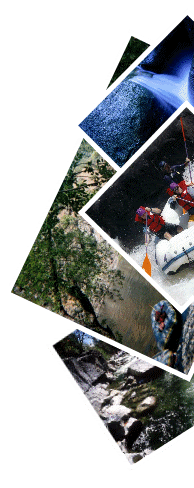














7 comments:
Ooh -- beautiful pix. I actually posted yesterday on Roxiticus Desperate Housewives about helicopter volcano tours in Costa Rica.
However...if the Genies had delivered a magic word counter instead of a magic lamp, I would be able to tell you precisely how far away "everything you always wanted to know about volcanoes but were afraid to ask" is from "almost wordless."
Have a great day!
Roxy
P.S. -- I got here today via the EntreCard hop...Layne is on my EntreCard widget, and you are on hers. Hop hop!
Not playing this week, but wanted to comment. The pictures are awesome. Have a great WW. :)
wow...pic no 2 ie. the Lava from Kilauea Flowing into the Pacific Ocean, Hawaii Volcanoes National Park look amazing.
and a brilliant post: mini geography class. ;)
Just here to votevotevote. Good luck in your Battle of the Blogs with Abe Lincoln.
Roxy
The images are awesome!! Great info to!
Hola Matt, I'm here waiting for my "surprise" he he!! :)
great post. I would love to follow you on twitter. By the way, did you learn that some chinese hacker had hacked twitter yesterday again.
[url=http://amazon.reviewazone.com/]Tina[/url]
Post a Comment